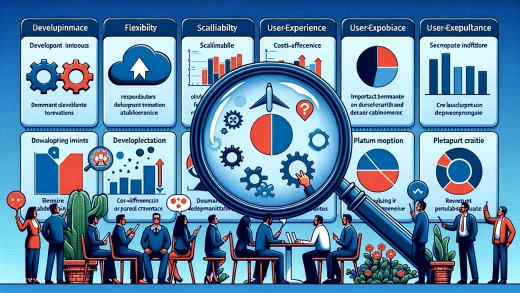Emerging Technologies Shaping Mobile App Development
Immersive Realities: The AR and VR Evolution
Imagine stepping into an app, and instead of tapping or swiping, you’re walking through a virtual shop or seeing your dream sofa projected into your living room. Sound futuristic? Not anymore! Augmented Reality (AR) and Virtual Reality (VR) are shaking up mobile app development like never before. Apps like IKEA Place and Pokémon GO have already given us a glimpse of what’s possible, but 2024 is set to push the boundaries even further.
From virtual try-ons in retail to AR-powered fitness guides that correct your yoga pose in real time, these technologies are becoming more advanced yet accessible. For developers, this means focusing on intuitive interfaces and lightning-fast responsiveness to make these experiences seamless.
- AR for education: Think interactive history lessons where ancient civilizations come alive in front of students.
- VR for therapy: Imagine apps helping people combat phobias by simulating safe environments.
The potential here? Limitless. As more devices become AR/VR-ready, apps that marry utility with wow-factor will steal the show. Are you ready to turn your app ideas into immersive experiences?
The Quantum Leap with Edge Computing
Picture this: no more waiting for apps to load or lagging screens just when you’re about to hit “confirm.” Thanks to edge computing, apps process data closer to where it’s created—your device—cutting down on delays caused by long server interactions.
Take healthcare apps, for instance. In emergencies, milliseconds matter. With edge computing, wearables can analyze your vitals instantly and deliver life-saving data straight to your doctor. Or how about gaming? Say goodbye to buffering; edge computing ensures smooth, uninterrupted gameplay even in complex multiplayer battles.
For app developers, it’s a goldmine: faster processing, reduced energy consumption, and enhanced user experiences. This tech isn’t just about speed; it’s about keeping data local and users happy. Expect apps in 2024 to harness this game-changing power, delivering seamless moments in ways you didn’t know you needed—but won’t want to live without.
AI and Machine Learning Driving App Innovations

Smart Apps That Seem to Know You Personally
The magic behind your favorite apps isn’t really magic—it’s AI and machine learning. These technologies are transforming mobile apps into something smarter, more intuitive, and surprisingly human-like. Imagine opening a fitness app that adjusts your workout plan because it “noticed” you skipped cardio for a week. Or think of an e-commerce app recommending not just trendy items, but exactly what fits your style based on your browsing habits. That’s not luck; that’s AI at work!
What’s truly captivating is how developers are re-imagining app experiences:
How does it feel when your favorite app seems to “get” you? Like it’s been designed only for you? That’s exactly where the future of apps is headed with machine learning leading the charge. Let’s face it—mobile apps aren’t just tools anymore. They’re evolving into personalized companions, and we’re here for it.
Smarter Interactions, Faster Solutions
Gone are the days of clunky dropdown menus and repetitive searches. Thanks to AI-driven chatbots and voice assistants, apps today can hold conversations almost indistinguishable from those with real humans. Think Alexa-level intelligence in apps like customer support or even meditation guides.
But it doesn’t stop there. Real-world applications are soaring:
The result? Apps that feel alive and responsive, adapting to your unique needs almost effortlessly. With every tap, swipe, or voice command, AI innovation is quietly steering us into a world where apps evolve alongside our lives. If that’s not futuristic, what is?
5G Technology Transforming Mobile Experiences

How 5G is Revolutionizing How We Use Mobile Apps
Imagine loading a movie in mere seconds, playing an online game with zero lag, or making a video call so crystal-clear it feels like teleporting. That’s the magic of 5G technology. With its lightning-fast speeds and low latency, 5G isn’t just “faster internet”—it’s rewriting the rulebook for how we experience mobile apps.
What does this mean for users like you and me? Here’s a taste of what’s already unfolding:
- Augmented reality (AR) apps that blend seamlessly into your real-world environment—think virtual furniture fitting perfectly in your living room.
- Cloud gaming that lets you dive into console-quality adventures on your morning commute, no chunky downloads required.
- Real-time health monitoring through wearables, offering instant data to both you and your doctor, wherever you are.
Mobile apps in the 5G era feel almost alive—responding faster, adapting smarter, and delivering experiences richer than ever before. It’s not just about convenience; it’s about breaking limits, creating moments that make you stop and say, “I can’t believe my phone just did that!”
Focus on User Privacy and Security Features

Your Data, Your Castle
In 2024, mobile app users aren’t just asking for security—they’re demanding it. And who can blame them? Our phones have become treasure chests of personal information: bank account details, sensitive messages, even those awkward selfies we swore to delete. To keep digital invaders at bay, apps are arming themselves with cutting-edge privacy and security measures.
Some apps now offer more than just a passcode. Imagine unlocking with layered defenses like biometric authentication (your thumbprint or even your face) coupled with end-to-end encryption. It’s like having a moat, a drawbridge, and a fire-breathing dragon all protecting your castle.
- Zero Trust architecture: Trust no one, not even the app itself, unless proven otherwise every time you log in.
- Device-specific permissions: Why should your flashlight app know your location? Apps today only ask for what they truly need.
The Human Touch in Cybersecurity
Privacy isn’t just about keeping bad actors out; it’s also about putting users back in control. Some platforms now include real-time data tracking dashboards, letting people see who’s accessing their data and why. Think of it as pulling open the curtains to catch a sneak peek behind the scenes.
Ultimately, users trust apps that aren’t just secure but transparent—because nothing feels better than knowing your virtual world is truly yours.
The Rise of Cross-Platform App Development

Why Developers Are Falling for Cross-Platform Solutions
Building separate apps for iOS and Android used to feel like choreographing two entirely different dances—time-consuming, expensive, and often a little chaotic. Enter cross-platform app development, the sleek, all-in-one solution that’s stealing the show in 2024. Instead of rewriting code for every platform under the sun, developers can create one app that dazzles across devices. It’s not just efficient; it’s downright liberating.
What’s driving this shift? Frameworks like Flutter and React Native. These tools are like the Swiss Army knives of app development, offering:
- Faster deployment: One codebase means quicker rollouts and updates.
- Cost efficiency: Fewer resources spent reworking code for multiple platforms.
- Consistent user experience: Apps that look polished and behave predictably, no matter where they’re opened.
Real Benefits Beyond the Code
For businesses, cross-platform is more than a technical switch. It’s about creating seamless connections with users, whether they’re on an Android wearing-down-the-battery commute or an iPhone tucked into a cozy café corner. Think about how apps like Instagram or Airbnb feel like home, regardless of the device. That’s the kind of magic cross-platform delivers.
And let’s not forget: With tech advancing at lightning speed, adaptability is everything. As new gadgets pop up—from foldable screens to futuristic AR glasses—apps born from cross-platform frameworks are better equipped to evolve. Isn’t that the kind of forward-thinking we all want in our digital lives?



